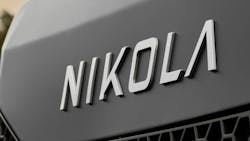Nikola CEO: 'We're all in, and there's no turning back.'
Nikola Corporation’s pivot away from battery electric trucks and full focus on hydrogen fuel cell EVs continues to pay off.
Nikola produced 77 trucks and shipped 73 during the second quarter, a 58% and 38% jump, respectively, year over year. Last quarter, executives aimed to ship 50 to 60 trucks in Q2, marking this as the second consecutive quarter they have beaten expectations.
Hyla, Nikola’s hydrogen refueling business, is also doing well, with one refueling station opened in Toronto, Canada, and modular stations being added and commissioned in California. The newest location in Long Beach, which opened in May, has already completed 700 fills, and CEO Steve Girsky said the company is still on track to provide 14 refueling stations by year-end.
Girsky, who took the CEO mantle in August 2023, repeatedly pressed Nikola’s advantage as the only Class 8 hydrogen fuel cell trucks commercially available in North America for the prospective partners it can bring in. Already, Girsky said, Nikola has been “getting more calls” not just from those looking to deploy the vehicles but also from “strategic partners like automotive OEMs, suppliers, hydrogen producers, and Big Energy who recognize [Nikola’s] key role as a first mover in the hydrogen economy.”
Nikola’s advantage extends to government programs as well. Girsky mentioned that Nikola had been named on several Clean Port Program applications. The program, run by the EPA and funded by the Inflation Reduction Act, will dispense $2.8 billion to projects that support deploying zero-emission technology at ports, as well as $150 million for climate and air quality planning. Seaport activity makes up more than a fourth of the country’s economy, and it’s estimated that replacing older cargo handling equipment with electric technology could reduce CO2 emissions in 2030 by up to 18% and in 2050 by up to 45%.
What Girsky called “perhaps the strongest tailwind” is the ARCHES program. The Alliance for Renewable Clean Hydrogen Energy Systems is a private-public partnership to bring clean hydrogen to California as the state works toward a zero-carbon economy. Earlier this month, ARCHES partnered with the Department of Energy on a $12.6 billion agreement and will begin building the first of seven regional hubs.
“We are excited to hear that $30 million, the first tranche of funding, will be deployed shortly as it’s a positive and encouraging sign that the hydrogen economy is growing,” Girsky said. “Nikola is well-poised to partner with ARCHES and the DOE for hydrogen station deployment and is named a network partner.
See also: Nikola, ITD Industries launch hydrogen station for heavy-duty transportation sector in Canada
Financially, Nikola is still a mixed bag, but the positives are steadily growing. Q2 was the company’s strongest quarter in history, with revenue of $31.3 million, double what it was a year ago and a 318% jump quarter over quarter.
As with most start-ups in the EV sector, losses remain high for Nikola, but the ship is slowly turning: Its gross profit was negative $54.7 million, twice what it was the same quarter last year, though net loss, $133.7 million, is a more than 50% reduction year over year. Adjusted EBITDA increased slightly from last quarter’s negative $104 million but still reduced from Q2 2023.
Going forward, Girsky and his team reaffirmed their delivery guidance for 300 to 350 fuel cell trucks, with between 80 and 100 wholesale deliveries expected in Q3. However, the CEO says Nikola will need time and resources to meet further goals.
“Building a zero-emission ecosystem piece by piece takes enormous time and resources. We cannot do it alone. We’ve been walking the talk with our […] trucks and hydrogen refueling stations,” he said.
“We’re all in, and there’s no turning back. Two trucks, one platform, all zero emissions … The more fuel cells we deliver, the more like-minded partners want to work with us.”
Nikola’s shares (Ticker: NKLA) have been on a downward trend over the past few months, following a brief high in March and April. Nikola reported earnings after market open on August 9, with shares opening at $8.45 per share. After earnings, though, the shares tumbled throughout the day, hitting a low of $7.57, but recovered to close at $8.44 per share. As of this writing, the price sits at $8.02 per share, putting its market capitalization at $405.8 million.
About the Author

Jennifer Ramsay
Jennifer Ramsay is an editor-at-large at Endeavor Business Media. In her role, Ramsay is responsible for curating several of the Market Moves newsletters and keeping tabs on the latest in the world of electric vehicles and clean energy.
